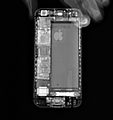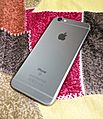IPhone 6s facts for kids
 |
|

iPhone 6s in Rose Gold
|
|
| Brand | Apple Inc. |
|---|---|
| Manufacturer | Foxconn (on contract) |
| Slogan | "The only thing that’s changed is everything." "One powerful phone" |
| Generation | 9th |
| Model | 6s: A1633 (North America) A1688 (International) A1700 (China) 6s Plus: A1634 (North America) A1687 (International) A1699 (China) |
| Compatible networks | GSM, CDMA, 3G, EVDO, HSPA+, LTE/4G, LTE Advanced/4G+ |
| First released | September 25, 2015 |
| Availability by country |
September 25, 2015
October 9, 2015
Andorra
Austria Belgium Bosnia and Herzegovina Bulgaria Croatia Czechia Denmark Estonia Finland Greece Greenland Hungary Iceland Ireland Isle of Man Italy Latvia Liechtenstein Lithuania Luxembourg Maldives Mexico Monaco Netherlands Norway Poland Portugal Romania Russia Slovakia Slovenia Spain Sweden Switzerland Taiwan October 10, 2015
October 16, 2015
November 6, 2015
November 13, 2015
March 31, 2017
|
| Discontinued | September 7, 2016 (16 and 64 GB) September 12, 2018 (32 and 128 GB) |
| Units sold | 13 million in launch weekend |
| Model before | iPhone 6 / iPhone 6 Plus |
| Replacement model | iPhone 7 / iPhone 7 Plus |
| Related | iPhone SE (1st generation) |
| Type | 6s: Smartphone 6s Plus: Phablet |
| Form factor | Slate |
| Size | 6s: 138.3 mm (5.44 in) H 67.1 mm (2.64 in) W 7.1 mm (0.28 in) D 6s Plus: 158.2 mm (6.23 in) H 77.9 mm (3.07 in) W 7.3 mm (0.29 in) D |
| Weight | 6s: 143 g (5.0 oz) 6s Plus: 192 g (6.8 oz) |
| Operating system | Original: iOS 9.0 Current: iOS 15.7.7, released June 21, 2023 |
| System on chip | Apple A9 |
| CPU | 1.85 GHz dual-core 64-bit ARMv8-A "Twister" |
| GPU | PowerVR GT7600 (hexa-core) |
| Memory | 2 GB LPDDR4 RAM |
| Storage | 16, 32, 64, or 128 GB TLC NAND connected via NVMe |
| Battery | 6s: 3.82 V 6.55 W·h (1715 mA·h) Li-Po 150 min charge time for an average of 8 h 15 min use 6s Plus: 3.8 V 10.45 W·h (2750 mA·h) Li-Po 165 min charge time for an average of 9 h 11 min use |
| Screen | 6s: 4.7 in (120 mm) Retina HD, LED-backlit IPS LCD, 1334 × 750 pixel resolution (326 ppi) with Dual Ion Exchange strengthened glass and 3D Touch 6s Plus: 5.5 in (140 mm) Retina HD, LED-backlit IPS LCD, 1920 × 1080 pixel resolution (401 ppi), 500 cd/m2 max. brightness (typical), with Dual Ion Exchange strengthened glass and 3D Touch |
| Rear camera | Sony Exmor RS IMX315 12 MP (1.22 μm), true-tone flash, autofocus, IR filter, burst mode, f/2.2 aperture, 4K video recording at 30 fps or 1080p at 30 or 60 fps, slow-motion video (1080p at 120 fps and 720p at 240 fps), timelapse with stabilization, panorama (up to 63 megapixels), face detection, digital image stabilization, optical image stabilization (6s Plus only) |
| Front camera | 5 MP, burst mode, f/2.2 aperture, exposure control, face detection, auto-HDR, 720p HD video recording, Retina flash |
| Sound | Mono speaker, 3.5 mm stereo audio jack |
| Connectivity |
All models:
LTE (Bands 1 to 5, 7, 8, 12, 13, 17 to 20, 25 to 29), TD-LTE (Bands 38 to 41), TD-SCDMA 1900 (F), 2000 (A), UMTS/HSPA+/DC-HSDPA (850, 900, 1700/2100, 1900, 2100 MHz), CDMA EV-DO Rev. A (800, 1700/2100, 1900, 2100 MHz), GSM/EDGE (850, 900, 1800, 1900 MHz), Wi-Fi (802.11 a/b/g/n/ac), Bluetooth 4.2, NFC, GPS, GLONASS, Galileo & QZSS
Models A1633 and A1634:
LTE (Band 30)
|
| Other | FaceTime audio- or video-calling |
| SAR |
6s
Model A1633, A1688, A1691, A1700
Head: 1.14 W/kg Body: 1.14 W/kg 6s Plus
Model A1634, A1687, A1690, A1699
Head: 1.12 W/kg Body: 1.14 W/kg |
| Hearing aid compatibility | M3, T4 |
The iPhone 6s and iPhone 6s Plus are smartphones made by Apple Inc.. They are the ninth generation of the iPhone series. These phones were first shown on September 9, 2015, in San Francisco. Pre-orders started on September 12, and they were officially released on September 25, 2015.
The iPhone 6s and 6s Plus looked a lot like the iPhone 6. However, they had many new and improved parts inside. This included a stronger body made of special aluminum. They also had a better camera that could record amazing 4K videos. For the first time, the front camera was improved and had a "Retina Flash" for brighter selfies.
A cool new feature was "3D Touch". This allowed the phone to sense how hard you pressed the screen. This opened up new ways to interact with apps. These iPhones were also among the first to use super-fast storage technology called NVM Express (NVMe). The iPhone 6s and 6s Plus were supported for a long time, receiving updates from iOS 9 all the way to iOS 15.
Contents
History of the iPhone 6s
Before the iPhone 6s was officially shown, there were many rumors about it. People guessed it would have a new rose gold color. They also heard about the special pressure-sensitive screen technology called 3D Touch.
The iPhone 6s and 6s Plus were officially revealed on September 9, 2015. This happened at a big event in San Francisco. You could start pre-ordering them on September 12, and they came out on September 25.
On September 7, 2016, Apple released the iPhone 7 and 7 Plus. These new phones took the place of the 6s and 6s Plus. However, the 6s models were still sold at a lower price.
The iPhone 6s, 6s Plus, and the first-generation iPhone SE were the last iPhones to have a standard 3.5 mm headphone jack. Apple stopped selling them on September 12, 2018.
What's Inside: iPhone 6s Specifications
Design and Colors
The iPhone 6s looked almost the same as the iPhone 6. But Apple made changes to make it tougher. The 6s was built with a stronger type of aluminum alloy. This helped prevent bending issues seen in the previous model.
Besides the usual gold, silver, and space gray colors, a new rose gold option was added.
| Color | Name | Front | Antenna |
|---|---|---|---|
| Space Gray | Black | Light Grey | |
| Silver | White | ||
| Gold | White | ||
| Rose Gold |
Power and Performance
The iPhone 6s uses a special chip called the Apple A9. Apple said this chip was much faster than the older A8 chip. It was 70% faster for general tasks and 90% better for graphics.
The iPhone 6s also had 2 GB of RAM. This was twice as much as any iPhone before it. The Touch ID sensor, which reads your fingerprint, was also improved. It could scan fingerprints much faster.
Battery Life
The batteries in the iPhone 6s and 6s Plus were a little smaller than in the iPhone 6 models. However, Apple said they would last about the same amount of time. The iPhone 6s battery was 1715 mAh, and the 6s Plus battery was 2750 mAh.
Even though it wasn't advertised, the iPhone 6s had some water resistance. This was thanks to a special silicone seal around important parts inside. This helped protect them from accidental water splashes.
Screen and 3D Touch
The screens on the iPhone 6s and 6s Plus were the same size as the iPhone 6 models. The 6s had a 4.7-inch screen, and the 6s Plus had a larger 5.5-inch screen.
A key new feature was 3D Touch. The screen had sensors that could tell how hard you pressed. This meant you could do different things by pressing lightly or pressing harder. For example, a light press might show you a preview, while a harder press would open something fully. The phone also vibrated slightly to give you feedback when you used 3D Touch.
Cameras
The iPhone 6s and 6s Plus had a much better camera system. The back camera was 12-megapixel, a big jump from the 8-megapixel camera on older models. The front camera was also improved to 5-megapixels.
For the first time on an iPhone, the rear camera could record 4K video. This is a very high-quality video. It could also record slow-motion videos. Many people liked the improved camera a lot. Keep in mind that 4K videos use up a lot of storage space quickly!
Storage Space
When they first came out, the iPhone 6s and 6s Plus were available with 16, 64, or 128 GB of storage. Later, the 16 GB and 64 GB options were replaced by a 32 GB model.
These phones used a fast storage technology called NVM Express (NVMe). This allowed them to read data very quickly, up to 1,840 megabytes per second.
Software: iOS Versions
The iPhone 6s came with iOS 9 when it was first released. This operating system used the new 3D Touch feature. You could "peek" at content with a light touch or "pop" it open by pressing harder.
The camera app had a "Retina Flash" feature. This used the screen's brightness to light up your face for selfies. There was also "Live Photos," which recorded a short video clip with each picture you took.
The iPhone 6s, 6s Plus, and first-generation SE were updated to many newer iOS versions. They supported iOS 12, iOS 13, iOS 14, and iOS 15. This means they received updates for a long time. These phones were the oldest iPhones to support iOS 13, 14, and 15.
However, in June 2022, Apple announced that the iPhone 6s and 6s Plus would not be able to update to iOS 16.
Common Issues
Battery Problems
In late 2016, Apple announced that a small number of iPhone 6s phones had battery issues. These phones were made between September and October 2015. Their batteries could cause the phone to unexpectedly shut down.
Apple said this was not a safety problem. They offered a free battery replacement program for affected phones. If your phone was in a specific range of serial numbers, you could get a new battery. Apple later explained that a part of the battery was exposed to air for too long during manufacturing.
Images for kids
See also
 In Spanish: IPhone 6s para niños
In Spanish: IPhone 6s para niños
- Comparison of smartphones
- History of iPhone
- List of iPhone models
- Timeline of iPhone models




